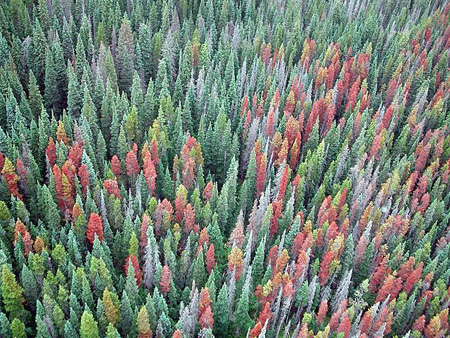Browse "Things"
-
Article
Influenza (Flu) in Canada
Influenza, often referred to as the flu, is a common, contagious respiratory illness. There are four types of influenza viruses: A, B, C and D. While influenza A, B and C viruses can infect humans, influenza D is believed to primarily affect animals such as cattle and pigs. Influenza C is rare in comparison to influenza A and B, which are the main sources of the “seasonal flu,” or the viruses that circulate in Canada and other countries each winter. Influenza A is also the source of flu pandemics. Canada has experienced five influenza pandemics since the late 19th century, in 1890, 1918, 1957, 1968 and 2009. In Canada, influenza causes an estimated 12,200 hospitalizations and 3,500 deaths each year.
"https://d2ttikhf7xbzbs.cloudfront.net/media/media/73780e73-cf0f-4654-b6da-da083ddb6c53.jpg" // resources/views/front/categories/view.blade.php
https://d2ttikhf7xbzbs.cloudfront.net/media/media/73780e73-cf0f-4654-b6da-da083ddb6c53.jpg
-
Article
Information and Communications Technology
Communications technologies include the techniques, tools and methods used to facilitate communication. Information technologies include those used to create, record, modify and display the content being communicated.
"https://d2ttikhf7xbzbs.cloudfront.net/media/media/528dd8b2-60b3-4853-9b1a-8c6731b71fe4.jpg" // resources/views/front/categories/view.blade.php
https://d2ttikhf7xbzbs.cloudfront.net/media/media/528dd8b2-60b3-4853-9b1a-8c6731b71fe4.jpg
-
Article
Information Highway
Information Highway is a term attributed to former American vice-president Al Gore in the 1990s and refers to the delivery of digital media over high-speed networks.
"https://development.thecanadianencyclopedia.ca/images/tce_placeholder.jpg?v=e9dca980c9bdb3aa11e832e7ea94f5d9" // resources/views/front/categories/view.blade.php
https://development.thecanadianencyclopedia.ca/images/tce_placeholder.jpg?v=e9dca980c9bdb3aa11e832e7ea94f5d9
-
Article
Information Society
Information SocietyFor many writers, pundits and policy makers the rapid development and diffusion of INFORMATION AND COMMUNICATIONS TECHNOLOGIES (ICT) heralds the development of a new kind of society - a society where the production and exchange of information is a key feature in both the economy and social life in general. While the first half of the 20th century saw the dominant form of economic production shift from agricultural to industrial, the second half was...
"https://development.thecanadianencyclopedia.ca/images/tce_placeholder.jpg?v=e9dca980c9bdb3aa11e832e7ea94f5d9" // resources/views/front/categories/view.blade.php
https://development.thecanadianencyclopedia.ca/images/tce_placeholder.jpg?v=e9dca980c9bdb3aa11e832e7ea94f5d9
-
Article
Injunction
An injunction is an equitable judicial remedy issued at the court's discretion. It usually takes the form of an order preventing or restraining a person from performing an act. The order may also take a mandatory form by compelling someone to do something.
"https://development.thecanadianencyclopedia.ca/images/tce_placeholder.jpg?v=e9dca980c9bdb3aa11e832e7ea94f5d9" // resources/views/front/categories/view.blade.php
https://development.thecanadianencyclopedia.ca/images/tce_placeholder.jpg?v=e9dca980c9bdb3aa11e832e7ea94f5d9
-
Article
Injury and Prevention
Some 2000 Canadians between the ages of one and 19 are killed each year because of injury, and over 85 000 are hospitalized. With the control of infectious diseases, injury has become the leading cause of death and disability in Canadian children and youth.
"https://development.thecanadianencyclopedia.ca/images/tce_placeholder.jpg?v=e9dca980c9bdb3aa11e832e7ea94f5d9" // resources/views/front/categories/view.blade.php
https://development.thecanadianencyclopedia.ca/images/tce_placeholder.jpg?v=e9dca980c9bdb3aa11e832e7ea94f5d9
-
Article
Innu Nikamu
An annual festival of traditional and contemporary Indigenous music, featuring hunters and musicians from Québec.
"https://development.thecanadianencyclopedia.ca/images/tce_placeholder.jpg?v=e9dca980c9bdb3aa11e832e7ea94f5d9" // resources/views/front/categories/view.blade.php
https://development.thecanadianencyclopedia.ca/images/tce_placeholder.jpg?v=e9dca980c9bdb3aa11e832e7ea94f5d9
-
Article
INRS - Armand-Frappier Santé Biotechnologie Research Centre
The Armand-Frappier Santé Biotechnologie Research Centre, is part of the Institut national de la recherche scientifique (INRS). It is an important centre for research, training and technology transfer (see Medical Education).
"https://development.thecanadianencyclopedia.ca/images/tce_placeholder.jpg?v=e9dca980c9bdb3aa11e832e7ea94f5d9" // resources/views/front/categories/view.blade.php
https://development.thecanadianencyclopedia.ca/images/tce_placeholder.jpg?v=e9dca980c9bdb3aa11e832e7ea94f5d9
-
Article
Insect
Insects are small invertebrates (more than 75% of known species are less than 6 mm long) with 3 pairs of legs, 1 or 2 pairs of wings (or lacking wings) and a segmented body.
"https://d2ttikhf7xbzbs.cloudfront.net/media/media/fc8d88c3-70d2-4a42-a06b-0c0e46e211ed.jpg" // resources/views/front/categories/view.blade.php
https://d2ttikhf7xbzbs.cloudfront.net/media/media/fc8d88c3-70d2-4a42-a06b-0c0e46e211ed.jpg
-
Article
Insect Classification
A classification system acts as an efficient storage mechanism for information about each taxon or group.
"https://d2ttikhf7xbzbs.cloudfront.net/media/media/62afc23f-dc49-4bc6-b03e-a1421aa6133e.jpg" // resources/views/front/categories/view.blade.php
https://d2ttikhf7xbzbs.cloudfront.net/media/media/62afc23f-dc49-4bc6-b03e-a1421aa6133e.jpg
-
Article
Insect Pests
Insects and humans cohabit the Earth and have developed complex relationships. Insect pests (less than 1% of all species) are those insects that feed on, compete for food with, or transmit diseases to humans and livestock.
"https://d2ttikhf7xbzbs.cloudfront.net/media/media/88c46837-1cef-4dd5-bc79-91bc360366f2.jpg" // resources/views/front/categories/view.blade.php
https://d2ttikhf7xbzbs.cloudfront.net/media/media/88c46837-1cef-4dd5-bc79-91bc360366f2.jpg
-
Article
Insectivora
Insectivora, order of mammals containing 7 living families: shrews, moles, hedgehogs, tenrecs, otter shrews, golden moles and solenodons.
"https://d2ttikhf7xbzbs.cloudfront.net/media/media/94b8c5dd-cf24-4982-b736-eabc3918b17a.jpg" // resources/views/front/categories/view.blade.php
https://d2ttikhf7xbzbs.cloudfront.net/media/media/94b8c5dd-cf24-4982-b736-eabc3918b17a.jpg
-
Macleans
Inside the Kyoto Deal
Albertas energy minister, Steve West, spent much of last week wearing a tight smile, his clenched jaw and square shoulders set as firmly as his conviction that people who blame the oilpatch for the next centurys foul weather have lost their heads.This article was originally published in Maclean's Magazine on December 22, 1997
"https://development.thecanadianencyclopedia.ca/images/tce_placeholder.jpg?v=e9dca980c9bdb3aa11e832e7ea94f5d9" // resources/views/front/categories/view.blade.php
https://development.thecanadianencyclopedia.ca/images/tce_placeholder.jpg?v=e9dca980c9bdb3aa11e832e7ea94f5d9
-
Macleans
Inside the Rig
This article was originally published in Maclean’s magazine on March 3, 1997. Partner content is not updated. On this crisp, clear mid-February afternoon, the mechanical colossus - the so-called topsides of the Hibernia drilling rig - towers over the shimmering waters of Newfoundland's Bull Arm.
"https://development.thecanadianencyclopedia.ca/images/tce_placeholder.jpg?v=e9dca980c9bdb3aa11e832e7ea94f5d9" // resources/views/front/categories/view.blade.php
https://development.thecanadianencyclopedia.ca/images/tce_placeholder.jpg?v=e9dca980c9bdb3aa11e832e7ea94f5d9
-
Article
Insolvency in Canada
Insolvency is a financial state defined by either of two situations. One is when a person, business or country cannot meet their obligations as they become due. The other is when the value of a person’s liabilities exceeds their assets.
"https://development.thecanadianencyclopedia.ca/images/tce_placeholder.jpg?v=e9dca980c9bdb3aa11e832e7ea94f5d9" // resources/views/front/categories/view.blade.php
https://development.thecanadianencyclopedia.ca/images/tce_placeholder.jpg?v=e9dca980c9bdb3aa11e832e7ea94f5d9
